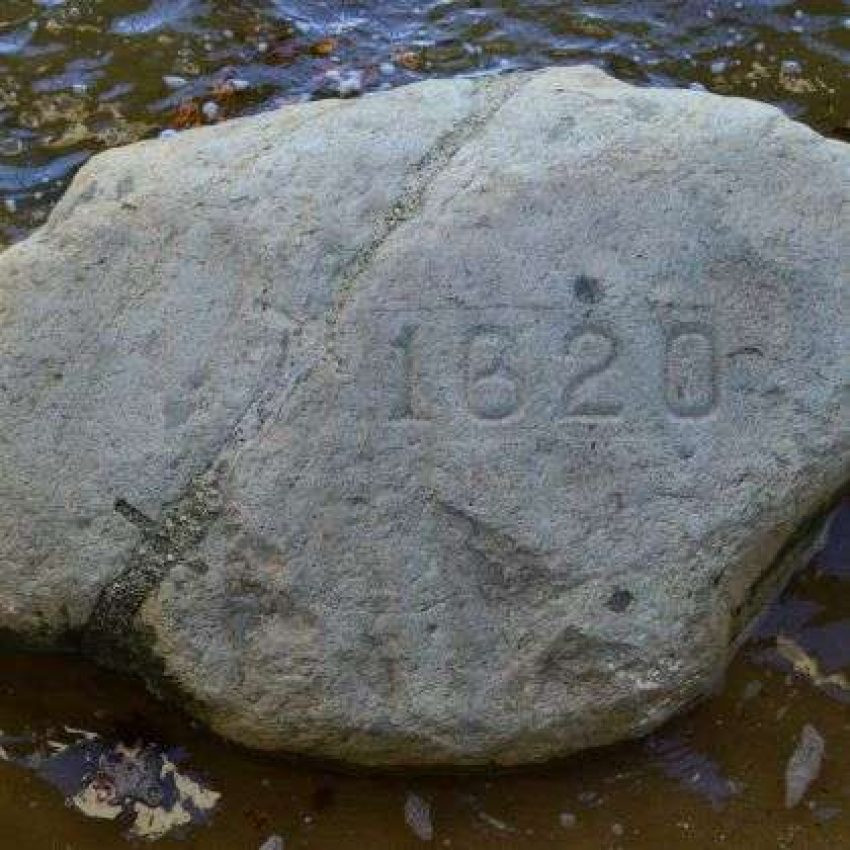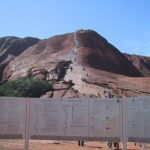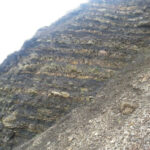Plymouth Rock, a seemingly simple glacial erratic boulder, holds immense symbolic weight in American history and continues to captivate millions of visitors each year. At rockscapes.net, we understand the allure of rocks, both as historical artifacts and elements of stunning landscapes. Join us as we delve into the appearance of Plymouth Rock, its historical significance, and how you can incorporate similar natural elements into your own outdoor spaces for an inspiring rock garden.
1. Unveiling the Appearance of Plymouth Rock
What exactly does Plymouth Rock look like? It’s more than just a rock; it’s a symbol. Plymouth Rock is, in essence, a glacial erratic boulder. These are rocks that differ from the size and type of rock native to the area in which it rests. Glacial erratics are carried by glacial ice, often over great distances. Plymouth Rock is a greyish-green granite. However, the visible portion today is only a fragment of the original rock. Over the centuries, it has been chipped away by souvenir hunters and damaged in various moves.
1.1 Size and Dimensions
Originally, Plymouth Rock was estimated to weigh around 200 tons. Today, the remaining portion is significantly smaller. It measures approximately 3 feet by 5 feet. However, its modest size belies its monumental significance.
1.2 Color and Texture
The rock’s greyish-green hue provides a subtle, natural appearance. Its texture is rough, bearing the marks of centuries of exposure to the elements and human interaction.
1.3 The Infamous Crack
Perhaps the most distinctive feature of Plymouth Rock is the large crack running through its center. This occurred during an attempt to move the rock in 1774. The crack serves as a poignant reminder of the rock’s fragility and the challenges it has faced throughout its history.
2. Historical Context and Significance
Why is Plymouth Rock so important? Plymouth Rock is said to be the site where the Pilgrims first set foot on American soil in 1620. While there’s no definitive historical evidence to confirm this claim, the rock became a powerful symbol of freedom and the founding of the United States.
2.1 The Pilgrims’ Landing
According to tradition, Plymouth Rock marks the spot where the Pilgrims disembarked from the Mayflower. This event is a cornerstone of American history, representing the beginning of a new chapter for the settlers seeking religious freedom.
2.2 Identification in 1741
The rock was officially identified as the Pilgrims’ landing spot in 1741, more than a century after the Mayflower’s arrival. Thomas Faunce, a 94-year-old church elder, vouched for its authenticity, claiming his father and original Mayflower passengers confirmed it as the exact landing spot.
2.3 A Symbol of Freedom
Regardless of its precise historical accuracy, Plymouth Rock quickly evolved into an American icon. It represents the courage, resilience, and pursuit of freedom that define the nation’s identity.
3. Plymouth Rock Through the Years: A Timeline
How has Plymouth Rock changed over time? Plymouth Rock has been subjected to various events that have shaped its appearance and significance.
| Year | Event | Description |
|---|---|---|
| 1620 | Pilgrims Arrive | The Pilgrims land near the rock, marking the beginning of European settlement in New England. |
| 1741 | Official Identification | Plymouth Rock is officially identified as the Pilgrims’ landing spot. |
| 1774 | The Great Crack | An attempt to move the rock results in a significant crack. |
| 1880 | Part of the Rock is Moved | A portion of the rock is moved to Pilgrim Hall Museum. |
| 1920 | Reunited Rock | The two sections of Plymouth Rock are reunited at the waterfront. |
| Present | Ongoing Preservation | Plymouth Rock is housed under a granite canopy, protected from the elements and visited by millions annually. |
4. Visiting Plymouth Rock Today
Where can you see Plymouth Rock? Plymouth Rock is located in Pilgrim Memorial State Park on the shore of Plymouth Harbor in Plymouth, Massachusetts. The park is open to the public, allowing visitors to view this historic landmark.
4.1 Pilgrim Memorial State Park
Pilgrim Memorial State Park is a meticulously managed location that provides a serene setting for reflection and education. It includes not only Plymouth Rock, but also statues and monuments honoring the Pilgrims.
4.2 The Granite Canopy
Plymouth Rock is now sheltered beneath a granite canopy designed by McKim, Mead & White in 1920. This structure protects the rock from the elements and provides a dignified setting for visitors to view the historical artifact.
4.3 Interpretive Programs
The park offers interpretive programs that delve into the history of Plymouth Rock. They explore its significance to American culture. Knowledgeable guides provide insights into the Pilgrims’ journey, the rock’s symbolism, and its place in shaping American identity.
5. Plymouth Rock and Landscape Design: Inspiration from History
How can Plymouth Rock inspire your landscape design? The rugged simplicity of Plymouth Rock, and the history of Plymouth, can be a wonderful muse for creating meaningful and evocative landscape designs. Here at rockscapes.net, we can help you find the perfect rock to create your dream landscape.
5.1 Natural Stone Elements
Incorporate natural stone elements into your landscape to evoke the timeless quality of Plymouth Rock. Use boulders, flagstones, and pebbles to create a sense of history and connection to the earth.
5.2 Native Plantings
Surround your stone features with native plantings to create a landscape that reflects the natural environment of New England. Choose plants that thrive in your local climate and complement the colors and textures of the stone.
5.3 Historical Themes
Consider incorporating historical themes into your landscape design. Use elements such as cobblestone pathways, wrought iron benches, and period-appropriate plantings to create a space that evokes a sense of the past.
 Plymouth Rock Close Up
Plymouth Rock Close Up
The details of Plymouth Rock, showcasing its unique coloration, textures, and natural weathering, inspire elements for your own rockscapes design.
6. Types of Rocks Perfect for Landscaping
What kinds of rocks can you use to recreate a Plymouth Rock aesthetic? While you may not have access to a glacial erratic boulder from Plymouth, Massachusetts, many types of rocks can help you achieve a similar aesthetic in your landscape.
6.1 Granite Boulders
Granite boulders are an excellent choice for creating a strong, grounding presence in your landscape. Their durability and natural beauty make them ideal for focal points, retaining walls, and water features. Granite is known to give off a very neutral effect.
6.2 Fieldstones
Fieldstones are naturally weathered stones that have been shaped by the elements over time. Their irregular shapes and earthy colors add a rustic charm to any landscape. They’re often used for pathways, borders, and accent features.
6.3 River Rocks
River rocks are smooth, rounded stones that have been polished by flowing water. Their soft textures and varied colors make them perfect for creating tranquil, Zen-like landscapes. River rocks are often used in dry creek beds, water features, and garden borders.
7. Designing with Rocks: Tips and Techniques
How can you effectively design your landscape using rocks? Designing with rocks requires careful planning and attention to detail. Here are some tips and techniques to help you create a stunning rock-inspired landscape.
7.1 Consider Scale and Proportion
When selecting rocks for your landscape, consider the scale and proportion of your space. Larger rocks can create a dramatic statement, while smaller rocks can add subtle texture and detail. Be sure to balance the size of the rocks with the surrounding elements of your landscape.
7.2 Create Visual Interest
Use a variety of rock sizes, shapes, and colors to create visual interest in your landscape. Mix and match different types of stones to add depth and complexity to your design.
7.3 Emphasize Natural Textures
Highlight the natural textures of the rocks by placing them in ways that catch the light and shadow. Use plants to soften the edges of the rocks and create a sense of harmony between the stone and the surrounding vegetation.
8. Sourcing Your Rocks: Finding the Right Materials
Where can you find the rocks you need for your landscape? Finding the right rocks for your landscape is essential to achieving your desired aesthetic. Here at rockscapes.net, we pride ourselves in helping people do just that.
8.1 Local Quarries
Local quarries are a great source for a wide variety of rocks and stones. Visit a quarry near you to see the available materials and get expert advice on selecting the right stones for your project.
8.2 Landscape Suppliers
Landscape suppliers typically carry a range of rocks, stones, and aggregates suitable for various landscaping applications. They can provide you with the materials you need and offer delivery services for larger quantities.
8.3 Rockscapes.net
Rockscapes.net is your ultimate resource for all things rocks. Browse our extensive collection of stones, boulders, and aggregates to find the perfect materials for your landscape project. We offer expert advice, design inspiration, and convenient online ordering.
9. Maintaining Your Rock Landscape
How do you keep your rock landscape looking its best? Maintaining your rock landscape is essential to preserving its beauty and longevity. Here are some tips for keeping your rock landscape looking its best.
9.1 Regular Cleaning
Remove debris, leaves, and weeds from your rock landscape regularly. Use a broom, leaf blower, or garden hose to keep the rocks clean and free of buildup.
9.2 Weed Control
Prevent weeds from growing in your rock landscape by applying a pre-emergent herbicide or using a natural weed barrier such as mulch or landscape fabric.
9.3 Erosion Prevention
Prevent erosion by ensuring proper drainage in your rock landscape. Use retaining walls, terraces, and strategically placed rocks to stabilize slopes and prevent soil loss.
10. The Enduring Appeal of Rocks in Landscape Design
Why are rocks a timeless element in landscape design? Rocks have an enduring appeal in landscape design due to their natural beauty, durability, and symbolic significance. They evoke a sense of timelessness and connection to the earth, creating spaces that are both visually stunning and emotionally resonant.
10.1 Natural Beauty
Rocks offer a diverse range of colors, textures, and shapes that can enhance the aesthetic appeal of any landscape. Their natural beauty complements a wide range of design styles, from rustic and traditional to modern and minimalist.
10.2 Durability
Rocks are incredibly durable and can withstand the elements for centuries. They require minimal maintenance and provide a long-lasting foundation for your landscape.
10.3 Symbolic Significance
Rocks hold symbolic significance in many cultures, representing strength, stability, and grounding. Incorporating rocks into your landscape can add depth and meaning to your outdoor spaces.
Plymouth Rock embodies the spirit of resilience, freedom, and the enduring connection between humanity and the natural world. By incorporating rocks into your landscape, you can create spaces that echo these qualities and provide a lasting source of inspiration and beauty.
 Plymouth Rock and Waterfront
Plymouth Rock and Waterfront
The picturesque setting of Plymouth Rock, with the harbor and surrounding landscape, shows the setting for inspiration in any rockscape project.
11. Rockscapes.net: Your Partner in Landscape Design
Ready to transform your landscape with the timeless beauty of rocks? Rockscapes.net is here to help. We offer an extensive collection of rocks, stones, and aggregates, along with expert advice and design inspiration to bring your vision to life.
11.1 Browse Our Collection
Explore our wide selection of rocks, from granite boulders to river rocks, to find the perfect materials for your landscape project.
11.2 Get Expert Advice
Our team of experienced landscape designers is here to provide you with expert advice and guidance every step of the way. Contact us today to discuss your project and receive personalized recommendations.
11.3 Start Your Project Today
Visit rockscapes.net and start your journey towards creating a stunning rock-inspired landscape that will enhance your outdoor living space for years to come.
Address: 1151 S Forest Ave, Tempe, AZ 85281, United States
Phone: +1 (480) 965-9011
Website: rockscapes.net
12. Recent Trends in Rock Landscaping in the USA
What are some current trends in rock landscaping? Rock landscaping in the USA is constantly evolving. Staying updated with the latest trends will help you create a modern, appealing outdoor space.
12.1 Xeriscaping
Xeriscaping is a water-wise landscaping method that uses drought-tolerant plants and rocks to minimize water usage. This trend is gaining popularity in arid regions of the USA, where water conservation is crucial.
12.2 Zen Gardens
Zen gardens, inspired by Japanese design, create a tranquil and meditative space using rocks, sand, and carefully placed plants. These gardens are perfect for creating a peaceful retreat in your backyard.
12.3 Gabion Walls
Gabion walls are structures made from wire cages filled with rocks. They offer a modern, industrial look and are commonly used for retaining walls, erosion control, and decorative features.
13. FAQ About Plymouth Rock and Rock Landscaping
Still have questions? Here are some frequently asked questions about Plymouth Rock and rock landscaping:
13.1 Is Plymouth Rock the actual rock the Pilgrims stepped on?
While there is no definitive historical proof, tradition holds that Plymouth Rock marks the spot where the Pilgrims first landed.
13.2 How big is Plymouth Rock?
The visible portion of Plymouth Rock measures approximately 3 feet by 5 feet.
13.3 Where is Plymouth Rock located?
Plymouth Rock is located in Pilgrim Memorial State Park on the shore of Plymouth Harbor in Plymouth, Massachusetts.
13.4 What types of rocks are best for landscaping?
Granite boulders, fieldstones, and river rocks are all excellent choices for landscaping.
13.5 How do I maintain a rock landscape?
Regular cleaning, weed control, and erosion prevention are essential for maintaining a rock landscape.
13.6 Where can I buy rocks for landscaping?
You can source rocks from local quarries, landscape suppliers, and online retailers like rockscapes.net.
13.7 What is xeriscaping?
Xeriscaping is a water-wise landscaping method that uses drought-tolerant plants and rocks to minimize water usage.
13.8 What are Zen gardens?
Zen gardens are tranquil and meditative spaces created using rocks, sand, and carefully placed plants.
13.9 What are gabion walls?
Gabion walls are structures made from wire cages filled with rocks. They are often used for retaining walls, erosion control, and decorative features.
13.10 How can I get started with rock landscaping?
Visit rockscapes.net for expert advice, design inspiration, and a wide selection of rocks and stones to bring your vision to life.
We at rockscapes.net hope this article has inspired you to explore the beauty and versatility of rocks in landscape design. Whether you’re creating a historical tribute or a modern masterpiece, rocks can provide a timeless foundation for your outdoor spaces.
Remember that all children must be accompanied by an adult when visiting rock-related sites.
Reasonable accommodations are available upon advance request.
Please call the park at 508-208-0675 for questions or additional information.
Let us help you bring your dream rockscape to life.

